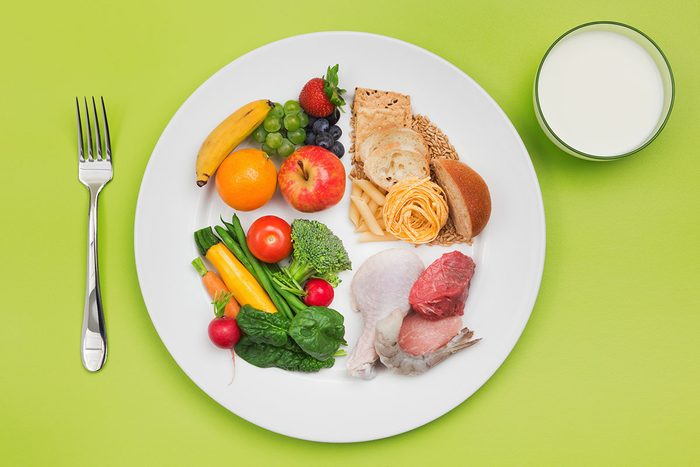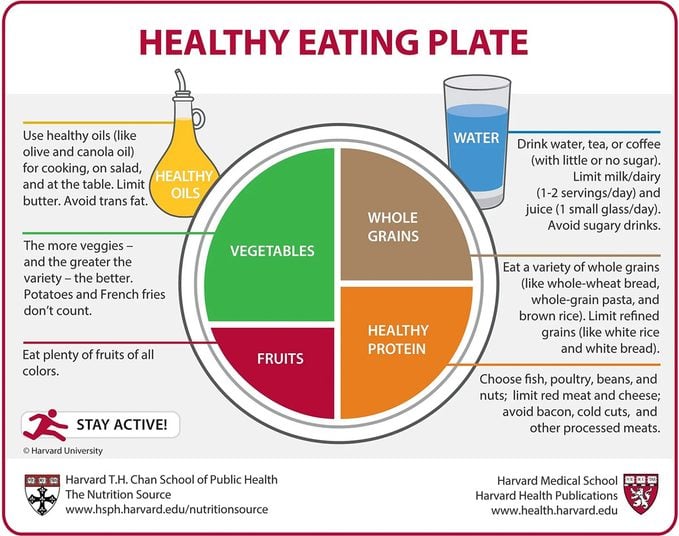What Is the Harvard Diet?
Updated: Apr. 04, 2023

This straightforward and reasonable way of eating may be the key to longevity and health, and it's simpler than many other fad diets.
Over the years, we’ve all heard about so many different diets. There’s the Mediterranean diet, the keto diet, the Atkins diet, the DASH diet, all sorts of various plant-based diets, fad diets and plenty of weight loss tricks that don’t really work. But one of the best ways to promote a long and healthy way might also be the most straightforward and reasonable. It’s called the Harvard Diet.
What Is the Harvard Diet?
The Harvard Diet’s proper name is the Healthy Eating Plate, which is a chart similar to the USDA’s My Plate—though with key differences. The Healthy Eating Plate advocates for eating more vegetables, choosing whole grains, skipping sugary drinks and limiting protein.
Moreover, the type of carbohydrate in the Harvard Diet is more important than the number of carbohydrates in the diet. That’s because some carbs, such as vegetables (other than potatoes), fruits, whole grains and beans are healthier than others. The Harvard Diet’s Healthy Eating Plate also advocates for people to use healthy oils in cooking. It does not set a maximum on the percentage of calories people should get each day from healthy sources of fat.
In this way, the Harvard Diet’s Healthy Eating Plate recommends the opposite of the low-fat message that’s been promoted for decades in the United States. This way of eating can help prevent cardiovascular disease, different types of cancers and type 2 diabetes.
What Are the Differences Between the Harvard Diet and USDA’s MyPlate?

While both the Healthy Eating Plate and USDA’s My Plate advocate for similar ideas, the key difference is that the Harvard Diet distinguishes between foods that are healthier than others.
For instance, while both charts advocate for eating vegetables, the Harvard Diet discourages eating potatoes. The USDA’s protein section could be filled by a hot dog or hamburger, but the Harvard Diet calls for healthier proteins such as fish, poultry, beans or nuts. The Healthy Eating Plate also calls for cooking with healthier oils and limiting the amount of dairy—while the USDA MyPlate encourages dairy at every meal.
How Do You Follow the Harvard Diet?
Here are some tips if you want to start incorporating the Harvard Diet into your life.
1. Most of your meal should be vegetables and fruits, at least half of your plate.
Aim for color and variety. Also, remember that potatoes don’t count as vegetables in the Harvard Diet because of their negative impact on blood sugar.
2. Make whole grains a quarter of your plate.
Go for whole grains such as whole wheat, barley, wheat berries, quinoa, oats and brown rice. Also choose foods made with whole grains, such as whole-wheat pasta. Whole grains have a milder effect on blood sugar and insulin than white bread, white rice and other refined grains.
3. Limit protein to a quarter of your plate and choose healthy proteins
Fish, poultry, beans and nuts are all healthy protein sources—they can be mixed into salads and pair well with vegetables on a plate. Limit red meat and avoid processed meats such as bacon and sausage.
4. Use healthy plant oils, in moderation
Healthy vegetable oils like olive, canola, avocado, corn, sunflower, peanut and others. Avoid partially hydrogenated oils, which contain unhealthy trans fats.
5. Stick to drinking water, coffee or tea
Skip sugary drinks and limit your intake of milk and dairy products. Limit juice to a small glass per day and dairy to one to two servings per day.
6. Be active!
The Healthy Eating Plate reminds us that staying active and exercising is also critical to controlling your weight.
Get The Healthy @Reader’s Digest newsletter and follow The Healthy on Facebook, Instagram, and Twitter. Keep reading:












